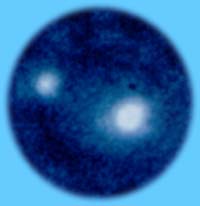duration - 5'48"
Click to hear an audio clip (duration: 1'06"): mp3 File (1 MB)
PROGRAM NOTES
Dancing in the Dark was inspired by a Hubble Space Telescope image of the planet Pluto and its relatively large satellite, Charon. The movement consists of a set of nine variations that feature a variety of regular rhythmic and timbral patterns. The result is set of "channels" of timbral continuities that operate at a deeper layer of the structure. Occasionally, as in variations 2 and 8, the coexistence of these timbral channels results in an aural illusion, an ambiguity of foreground and middleground, that is quite similar to such well-known visual illusions as those seen in Escher drawings.The pitches for the piece are those found in a just scale based on twenty equal divisions of a perfect fifth, with middle-C as the tonic. Each of these divisions is slightly larger than an interval of 35 cents, and the result is very similar to Wendy Carlos's gamma tuning. A special property of this scale is that it can be used to form very pure major and minor thirds, and so the tertian harmonies used in this piece are therefore quite clear and beautiful.


